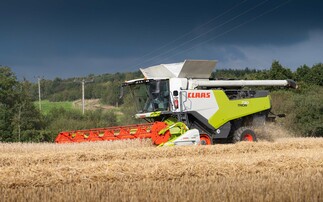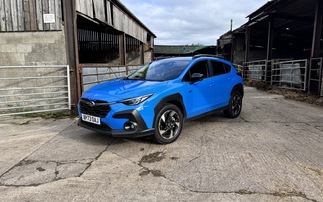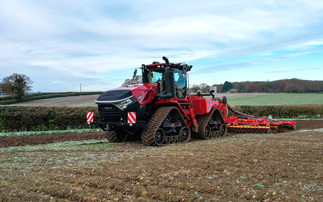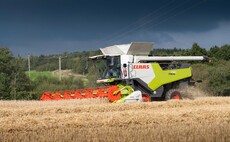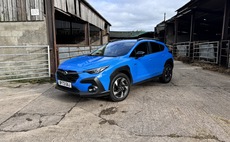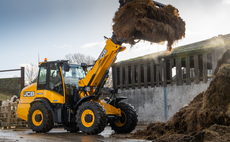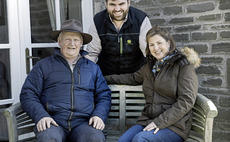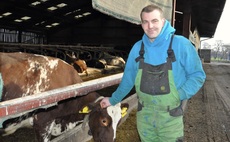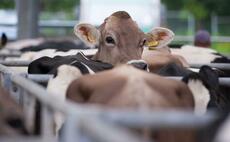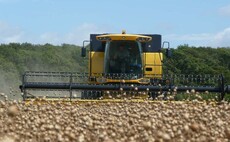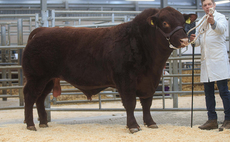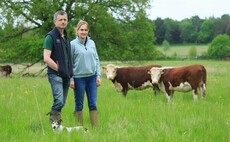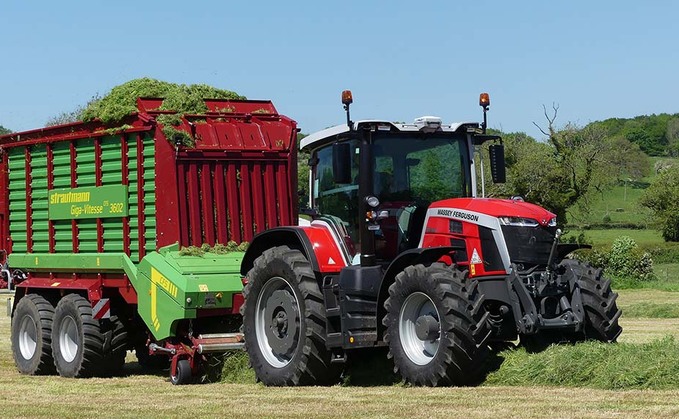
When it comes to Massey Ferguson's 8S tractor, there has been plenty of hype, plenty of talk and more than enough opinion. To find out more about it, James Rickard gets behind the wheel of two examples. Pictures by Geoff Ashcroft.
Up until now, Massey Ferguson's updates to its tractors have been fairly gradual over the years, with a continuing raft of subtle, evolutionary changes. However, with the introduction of the 8S, this has all changed.
Yet, while the 8S continues to split opinion, most would agree that this is something that Massey Ferguson needed to do, to reassert itself in the market place and stand out among a raft of strong competitors.
As you can probably tell, the 8S takes a lot of design inspiration from MF's heritage, such as the 2000 and 3000 Series tractors. Combined with radical features, such as the forward leaning cab and detached engine bay, much of the design is not just for the sake of it either, with clever thinking behind air flow, heat management and noise control, all contributing to the way the tractor looks.
Effectively, the 8S Series is the replacement for the manufacturer's long wheelbase 7700S models.
Four models make up the series; 8S.205, 225, 245 and 265 - the model number denotes maximum power and all models get a 20hp boost.
There are currently two transmission options available; Dyna-7 and Dyna-E-Power. Both are 28-speed semi-powershift gearboxes, with the Dyna-E-Power versions benefitting from dual clutch technology (see transmission panel). A Dyna-VT continuously variable transmission (CVT) is still to come.
Differences
In addition, two specification levels are available; Efficient and Exclusive, with the most visual differences between the two occurring in the cab (see controls and layout panel).
To get a good flavour of the new 8S tractor series, we tried out two different models, carrying out two different jobs.
An 8S.205 Dyna-7 with a six-furrow Kverneland on-land/in-furrow plough provided a chance to try the tractor at draft work, while an 8S.265 Dyna-E-Power, equipped with a Strautmann Giga Vitesse 3602 forage wagon, provided an opportunity to use the tractor for some high power pto work and transport duties. A big thank you must also go to the Thurlow Nunn Group and PV Dobson for providing the tractors.
Engine
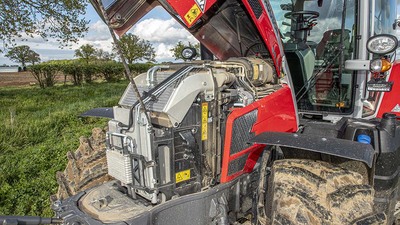
As per the models the 8S replaces, apart from the 7720 which used a 6.6-litre engine, all 8S models get a 7.4-litre Agco Power engine. It is a tried and tested motor and one which likes to lug. On the plough it was happy to be pulled down to 1,400rpm, where it would sit all day. Similarly, for forage wagon work, it is an engine that can be leaned on, to make the most of its power.
When it comes to the boost feature, using the 8S.265 as an example, this boosts to a maximum of 285hp. For transport, this is a gradual increase in power between six and 18kph; above 18kph, you get full boost. For pto work, in 1,000 and 1,000E pto speeds, when these are engaged and as soon as the tractor moves, you get all of the boost. For hydraulic work, boost will kick in as and when it detects a load on the hydraulics. So pretty generous.
As mentioned, the design and layout of the engine bay and bonnet contribute to how air flow and heat are managed. For all cooling air, this is drawn in through the front of the bonnet, with cool air pulled through the radiators and hot air expelled out the sides of the bonnet.
Aspiration
This control over airflow continues around the back of the engine bay, in the large gap between it and the front of the cab, where fresh air is drawn into the engine for its aspiration. According the manufacturer, this is where the cleanest air can be found when the tractor is working.
While it looks a tad bizarre, this large gap between the engine and the cab also serves to protect the operator from noise, vibration and heat. And the effect it has is very noticeable.
For daily checks and maintenance, as well as the wide opening bonnet, side panels can also be removed the latter mainly for annual servicing.
While the fixed radiator packs do not fold out, there is a service hatch which can be removed, revealing plenty of space to get your hands and an airline in between the radiators.
Down the sides of the radiator are also guide rails, which firmly hold the bonnet in place, helping to keep a tight seal around the radiators. This minimises the chances of any dust or dirt from entering the radiators.
Transmission
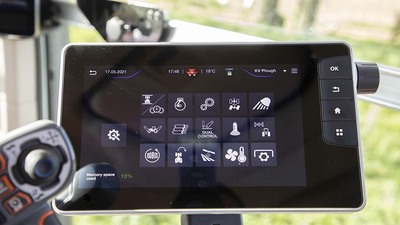
As mentioned, the 8S is currently available with a choice of two semi-powershift transmissions; Dyna-7 and Dyna-E-Power. However, unlike its current models, it does not say on the side of the bonnet what transmission is in the 8S. And because the controls look the same for both variants, it is not until you fire it up you spot the difference.
While both transmission options feature four ranges with seven gears in each range, they differ significantly in the way they change range. As Dyna-6 currently does, Dyna-7 uses electro-hydraulic range changes - robotised range changes, in other words.
Dyna-E-Power on the other hand uses dual clutch technology to achieve this. It is a technique adopted by several tractor manufacturers these days, able to achieve quicker gear changes with reduced break in drive, increasing efficiency. As such, Dyan-E-Power can be pretty much driven like a full powershift.
Particularly with the E-Power transmission, and the way is ‘skips' gears to avoid overlap and achieve a consistent increase/decrease in speed, it actually only uses about 22 gears out of the 28 available. This said, the 22 it uses will not always be the same, which will vary depending on job. The most skipped gears are around the range two area.
With Dyna-E-Power, ranges and range changes effectively do not exist - it is basically a full powershift.
Powershift
Like Dyna-7, you can set two cruise speeds, and you can set what the top speed is. This is done either by getting up to speed and pressing and holding the cruise button to save, by adjusting it using the scroll wheel on the MultiPad lever or by setting it through the touch screen terminal. This makes it very flexible to set-up and should suit multiple types of user.
Like Dyna-6, you can also pre-programme a start off gear. Thankfully, this is much easier than before, just by using the scroll wheel on the MultiPad lever.
Likewise, for Dyna-E-Power, you can set a start of gear for manual mode, or for automatic mode, you can set a start off speed, which, when you let the clutch out is the speed the tractor will immediately aim for.
Operation
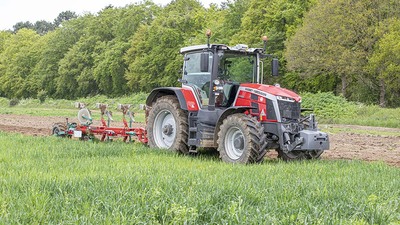
Both transmission types can be driven in manual or automatic modes. As we found, whether Dyna-7 or E-Power, the tractor almost encourages you to drive it in automatic, which, where possible, we did with both jobs.
On the plough, with the 8S.205 Dyna-7, we set the transmission to auto, but limited its changes to within one range. This prevented it from making any unexpected gear changes, but we also set a cruise speed, much like you would do with a continuously variable transmission (CVT). It worked very well, too, with the tractor working out the best revs and ratios for that particular job. In this case, with a six-furrow plough, it just cruised along at 1,400rpm, achieving about 8kph.
For both transmissions, in auto, the accelerator and MultiPad lever become your speed control tools, like a CVT. Particularly when using the lever, you are not directly controlling the transmission, rather giving the tractor an instruction to either speed up or slow down, with it working out what gear to be in and what revs to use.
In addition, by pushing the lever right forward through a detent, like Deere's CommandPro set-up, this will tell the tractor to immediately go to top speed/the top speed limit set.
Wagon
On the forage wagon with the Dyna-E-Power, auto-mode was mainly used for the transport element of the job.
It worked well too, offering smooth gear changes and, more often than not, gear changes at the right time, which is something automated systems often struggle with on tractors.
For picking up the crop with the forage wagon, we put the transmission back to manual, to give absolute control over forward speed. Also, at this point, there is not much more the tractor can do for you in automatic, as the revs are pretty much flat out.
For a pto job which is more consistent, like mowing, then we would be tempted to leave it in automatic all of the time and use the cruise speeds; possibly one for work and one for the headland.
Overall, the transmission is very easy to use and also provides plenty of flexibility of set-up.
Cab
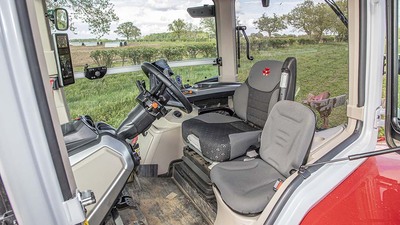
From the outside, you may be forgiven for thinking the cab design is a bit too much, however, it all starts to make sense once sat in the seat. From here, the massive cab space, generous all-round visibility and new control layout are all standout features.
Relating a lot to the cab, there are two specification levels available; Efficient and Exclusive. While Exclusive can be specced with all features an options, Exclusive is a more trimmed down version which can be specified with less toys and mechanical spools, as an example.
From the seat, the engine bay looks like a ‘pod' sat out in front. This tapers rearwards, contributing to the impressive forward views. You can actually see the front linkage.
The massive one-piece front windscreen provides as equally big views to the front and around the middle of the tractor. It also comes with a huge wiper, which gives great coverage of the windscreen. A right hand side wiper is also available as an option.
Interestingly, because of the forward leaning windscreen, less sunlight hits your legs.
Steering column is easy to adjust, featuring a new ‘set and forget' feature which allows you to bring the steering straight back to the position you set. This makes it much easier to quickly get in position when hopping back on the tractor.
Reacts
For comfort, two cab suspension options are available. Standard on Exclusive models is electrically controlled suspension, which can be set to soft or hard, or you can leave it in automatic, which reacts to front axle suspension movement to counteract the bumps. On the whole, this system copes well. You can also opt for mechanical cab suspension; both options feature an anti-roll bar.
Heating and ventilation has also been well thought about, with plenty of vents dotted around the cab. There are also vents now at feet level, something which previous models were missing.
Thanks to big steps and a wide opening one piece door, access into the cab is unhindered. However, it is a big door and time will tell how this fares in the real world. Perhaps a five post cab with a smaller door might be an idea for the future. This said, this is not the size of tractor which you will be hopping on and off a lot.
Controls
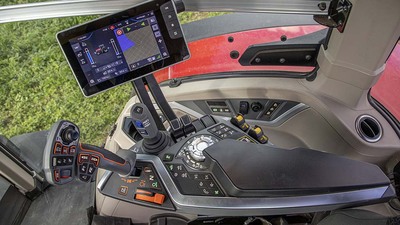
Both specification levels get MF's new armrest control layout with the new MultiPad lever. Again, on first inspection, it is a design which appears a bit radical. But after a short study, most things make sense and it is relatively easy to get on with. Effectively, it is a really good evolution of what the manufacturer had before.
Likewise, the new MultiPad lever takes what MF had before and improves it, offering greater features and functions. One of which is a new integrated mini-joystick which can take care of any spool you assign to it.
Several other buttons can also be assigned various jobs, particularly the new ‘F' keys, making operation of implements more convenient than before.
The layout of the MultiPad is also user friendly, with different shaped buttons making it easy to feel what each button does, without having to look. This is in contrast to many joysticks on the market with buttons which all feel the same, where you end up having to look for the button you want to press.
Configured
On Exclusive models, a second joystick is also standard, which is useful for front linkage control, for example. But again, this can be configured to control a variety of things.
Sticking with a bit of tradition is the use of MF's now legendary Power Control lever, mounted on the steering column. More than a shuttle lever, you can also change gear with it and it now features a proper park position which locks the transmission.
To monitor vitals, this is now taken care of by a pillar-mounted dash. Giving the cab a bit of a big American tractor feel, it puts all you need to know at eye level, such as fuel level, engine temperature, AdBlue level, forward speed and engine rpm. In the middle of the display are indicators which show what has been activated, such as 4WD and diff-lock. Then at the bottom are graphics which show things like the state of the transmission, cruise speeds and what has been assigned to the F keys.
In all, it offers a very clear way of seeing information at a glance, featuring bold and colourful graphics. It also opens up the area around the steering column, adding to the forward visibility.
Terminal

Taking care of all tractor setup on Exclusive models as standard is the firm's nine-inch Datatronic 5 touch screen terminal. In addition to tractor setup, it can also look after guidance, IsoBus control and variable rate and section control. You can also tie in images from a variety of cameras on the tractor, including a reversing camera.
As well as Datatronic 5, you can also specify the firm's Fieldstar 5 terminal. This looks identical to the Datatronic 5 unit and can carry out many of its duties, but does not have the ability to set the tractor up. If this was your only screen in the tractor, a lot of setup can then be done through the dash.
With iPad-like control, Datatronic 5 is very smooth and responsive - a shear world away from Datatronic 4.
From start up, Datatronic 5 greets you with a simple home screen featuring an image of the tractor and all of its main parameters such as linkage position and spool valve status. Any one of these parameters can then be tapped and adjusted.
To the left of the main image is a column of easily customised key information. This can be anything from forward speed to wheelslip levels.
From this home screen you can swipe left or right to three main other screens; IsoBus, guidance or video screen. This gives you a quick route to key functions without having to go through any layers.
Physical controls
Once in any of the four screens, a menu button can be pressed from where all functions can be setup and adjusted. It really is very simple to fathom; see it, press it, adjust it. Physical controls on the right hand side of the screen also allow an alternative to touchscreen navigation, which is useful when on the move.
Finally, if you want to see more at once, the screen can be split in two and it features day and night modes with an automatic dimming function. Glare off the sun never seemed to be an issue either.
Overall, between the two specification levels, spec choice is quite flexible, allowing you to better tailor the tractor to your requirements. For instance, you could go from an Efficient machine with mechanical spools and no screens, to something in between with half mechanical/electric spools and one screen, to a top-spec Exclusive machine with all electric spools and two screens.
Brakes and suspension
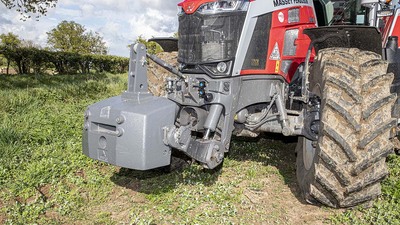
At the rear of the tractor, braking performance has been boosted, which now sees multi-disc brakes used (five discs and five counter discs each side), featuring ball and ram actuators. It is not a new idea, used on MF 590 models, but it does bring with it quicker releasing brakes which should add up to greater efficiency.
On the front of the transmission is a multi-plate clutch pack which takes care of 4WD engagement. This is said to be a better solution compared to brakes in the front axle's hubs, which can run hot.
Unlike Case IH and New Holland which make good use of an exhaust brake, the 8S does not get one.
However, when the brakes are pressed, the engine's viscous fan is put into full power mode, providing 15 per cent extra engine braking.
Wheelbase
In contrast to most of the tractor, the front axle suspension is one of few components carried over from the long wheelbase 7700s. It works well too, largely thanks to a long pivoting arm which connects to the rear of the sump, affording good control over the front axle.
Designed and built by Massey Ferguson, it always finds its centre position, no matter what load is on the front, it can also be adjusted and it can be turned off if you wish.
In terms of downsides to the rear of the tractor, the areas in and around the rear axles are prone to a build-up of debris. This was particularly evident on the forage wagon, with stray crop building up on all the pipework above the rear axles. Perhaps some shrouding, like other manufacturers, in these areas would help.
Also, because the large rear mudguards ‘tip' inwards towards the cab, dirt can also build up where the mudguards meet the cab.
Hydraulics and pto
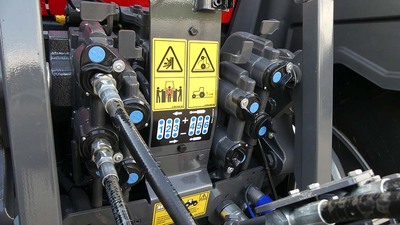
For hydraulics, the 8S uses a separate reservoir to the transmission, reducing the risk of oil contamination and offering a greater hydraulic oil take out. Hydraulic tank is filled near the right hand cab steps and requires no dipstick to check its level. Instead, this comes up as a reading on the dash, when the tractor is started.
As standard, the tractor comes with 150 litre/minute hydraulic pump, with 205 and 205 economy options - the latter achieves full hydraulic flow at 1,600rpm.
Due to this being a UK-spec 8S, only a maximum of four, double-acting spools can be specified at the rear.
This is due to the space that the pickup hitch's lift rods take up. If it was not for these you could specify up to six spools. This said, pickup hitch does not need one of these spools, as it has its own dedicated supply, and there are also up to three mid-mount spools available, so, while on the surface the UK-spec seems limited, it is actually quite generous. And like the rear, the front can also be specified with a free-flow return.
For the Exclusive top-spec package, rear spools come with depressurisation levers, which help a lot with coupling/decoupling oil pipes.
Integrated
Pickup hitch is courtesy of Dromone. Control of this is by its own handle in the cab. Integrated into the handle are buttons for both the hitch raise/lower and the hitch push/pull actions. It is a neat control package and a bit of a revelation.
Linkage lift capacity at the front and rear have both been boosted; now 10 tonnes at the rear, was 9/9.8t (depending on spec) and 4.8t on the front, was 4t.
If specified with a front pto (1,000rpm), this also gets its own oil cooler. Four speeds are available for the rear pto, all electronically engaged, with the ability to adjust start-up aggression.
For pto operation, engine rpm is rated to 1,900rpm for maximum power and 1,500rpm for eco-pto speeds.
Specifications
Model tested | ||
Six-cylinder, 7.4-litre, Agco Power | Six-cylinder, 7.4-litre, Agco Power | |
Maximum power | ||
Power with engine management | ||
Maximum torque with engine management | 1,200Nm | |
Engine service intervals | 600 hours | 600 hours |
Transmission | 50kph, Dyna-7, 28-speed, semi-powershift | 50kph, Dyna-E-Power, 28-speed, semi-powershift with dual clutch technology |
Diesel tank capacity | 460 litres | 460 litres |
AdBlue tank capacity | 43 litres | 43 litres |
Hydraulic pump capacity | 150 or 205 litres/minute, or 205 litres/minute economy | 150 or 205 litres/minute, or 205 litres/minute economy |
Rear linkage lift capacity | 10,000kg | 10,000kg |
Front linkage lift capacity | 4,800kg | 4,800kg |
Wheelbase | 3,050mm | 3,050mm |
Unladen weight | 8,700kg | 8,700kg |
Maximum permissible weight | 16,000kg | 16,000kg |
Verdict
As the headline states, the new 8S is a proper statement piece. And whether you like the look of it or not, it was something the manufacturer definitely needed to do.
Flexibility certainly seems to be one of the 8S's strengths, both in terms of how you can specify this tractor and operate it, which should appeal to a wide customer base.
From an operation point of view, it has been pretty easy to get on with and ditches a lot of those Massey Ferguson-isms which have built up over the years, making it much easier for non-MF operator to get on with.
Performance also stood out during our range of tasks, with the Agco Power engine proving to be a formidable unit. But, while we have enjoyed the new transmission and its CVT-like driving style, we are looking forward to a proper CVT model when this becomes available.
And now we have seen what the firm has done with the replacement for the 5700S Series with the 5S models, it will be interesting to see what the manufacturer comes up with to replace the 6700S and short wheelbase 7700S models. Styling-wise, we now have a good idea of what the replacements will look like, but will any of them get this new cab, especially the short wheelbase 7700S models? It will be a crying shame if they do not!














